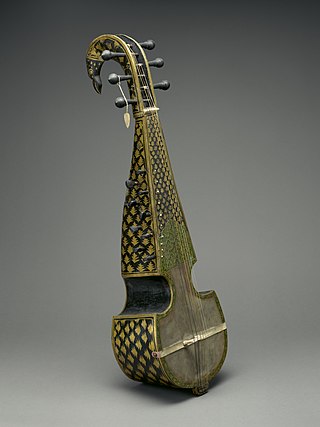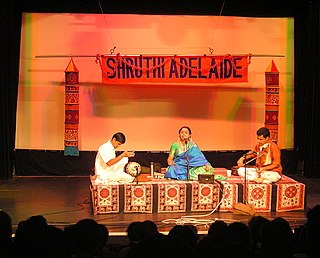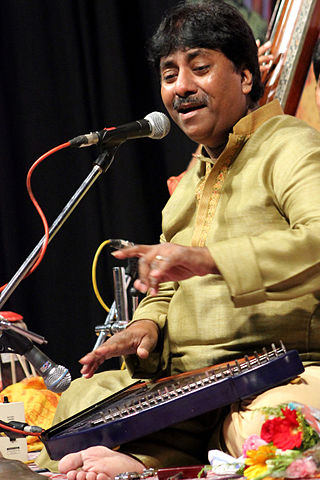
Carnatic music or Karnataka Sangita is a system of music commonly associated with South India, including the modern Indian states of Andhra Pradesh, Karnataka, Kerala, Tamil Nadu and portions of east and south Telangana and southern Odisha.
ITC may stand for:

The sarod is a stringed instrument, used in Hindustani music on the Indian subcontinent. Along with the sitar, it is among the most popular and prominent instruments. It is known for a deep, weighty, introspective sound, in contrast with the sweet, overtone-rich texture of the sitar, with sympathetic strings that give it a resonant, reverberant quality. A fretless instrument, it can produce the continuous slides between notes known as meend (glissandi), which are important in Indian music.
Hindustani classical music is the classical music of the Indian subcontinent's northern regions. It may also be called North Indian classical music or Uttar Bhartiya shastriya sangeet. The term shastriya sangeet literally means classical music, and is also used to refer to Indian classical music in general. It is played on instruments like the veena, sitar and sarod. It diverged in the 12th century CE from Carnatic music, the classical tradition of Southern India. While Carnatic music largely uses compositions written in Sanskrit, Kannada, Telugu, Tamil, Malayalam, Hindustani music largely uses compositions written in Hindi, Urdu, Braj, Avadhi, Bhojpuri, Bengali, Rajasthani, Marathi and Punjabi.

The shruti or śruti is the smallest interval of pitch that the human ear can detect and a singer or musical instrument can produce. The concept is found in ancient and medieval Sanskrit texts such as the Natya Shastra, the Dattilam, the Brihaddeshi, and the Sangita Ratnakara. Chandogya Upanishad speaks of the division of the octave in 22 parts.

Ustad Rashid Khan was an Indian classical musician in the Hindustani tradition. He belonged to the Rampur-Sahaswan gharana and was the great-grandson of gharana founder Inayat Hussain Khan.
In Hindustani music, meend refers to a glide from one note to another. It is an essential performance practice, and is used often in vocal and instrumental music. On the veena, sitar, sarangi and other plucked stringed instruments, it is usually done by pushing the strings across the frets to vary their effective length and tension; compare portamento and finger vibrato. This can be done on wind instruments like the bansuri by using the fingers to cover the holes in a manner that the changes between discrete pitches are imperceptible. It is considered a sort of alankar, or ornament.
Gamaka refer to ornamentation that is used in the performance of North and South Indian classical music. Gamaka can be understood as embellishment done on a note or between two notes. Present-day Carnatic music uses at least fifteen different kinds of ornamentation. Gamaka is any graceful turn, curve or cornering touch given to a single note or a group of notes, which adds emphasis to each raga's individuality. Gamaka can be understood as any movement done on a note or in between two notes. The unique character of each raga is given by its gamakas, making their role essential rather than decorative in Indian music. Nearly all Indian musical treatises have a section dedicated to describing, listing and characterising gamakas.
Darbari Kanada, or simply Raga Darbari, is a raga in Carnatic music. It is a janya ragam of 20th Melakarta raga Natabhairavi. Being an ancient raga, its original name is unknown. It is believed to be borrowed into Hindustani classical music by Miyan Tansen, the famous 16th-century composer in emperor Akbar's court. It belongs to the Kanada family. This tradition is reflected in the name itself; Darbar is the Persian derived word in Hindi meaning "court." As the most familiar raga in the Kanada family, it may sometimes also be called Shuddha Kanada or pure Kanada. It belongs to the Asavari thaat. This raag is called raaga Kaanada in Yakshagana Karnataka state dance. It is also sometimes written as Durbari and Durbarikanada.
Bhimpalasi or Bheempalasi is a Hindustani classical raga. The Carnatic Music equivalent of this raga is Abheri.
Raga Bihag is a Hindustani classical raga belonging to the Bilawal thaat. Bihag uses all seven music swars, and both Madhyams are used. The Shuddha Madhyam is more prominent; tivraMadhyama is only used with Panchama in the phrase PA MA' GA MA GA.
Gandharva Mahavidyalaya New Delhi is an institution established in 1939 to popularize Indian classical music and dance. The Mahavidyalaya (school) came into being to perpetuate the memory of Pandit Vishnu Digambar Paluskar, the great reviver of Hindustani classical music, and to keep up the ideals set down by him. The first Gandharva Mahavidyalaya was established by him on 5 May 1901 at Lahore. The New Delhi school follows the syllabi set by the Akhil Bharatiya Gandharva Mahavidyalaya Mandal.

Lalith J. Rao is an Indian classical singer and a representative of the Agra gharana.
ITC Sangeet Research Academy is a Hindustani classical music academy run by the corporate house, ITC Ltd. It is located in Kolkata, India. Noted musicians associated with the academy include Ulhas Kashalkar, Falguni Mitra, Ajoy Chakrabarty, Ustad Rashid Khan, Mashkoor Ali Khan, Girija Devi, and Subhra Guha. Satyajit Ray, was one of the trustees.

ITC SRA Sangeet Sammelan is an annual Indian classical music festival organised by ITC Sangeet Research Academy held by turn in various cities in India.
Murki is a short taan or inverted mordent in Hindustani classical music, known as pratyahatam in Carnatic music. It is a fast and delicate ornamentation or alankar, employing two or more notes and is similar to a mordent or ulta murki. A murki is less forceful than a khatka or a zamzama. A combination like R R S S could be a murki or a khatka or the starting point of a zamzama, depending on the force of delivery. Murkis may or may not be appropriate for a given raga. It is also employed in thumris and other lighter genres.
Alankara, also referred to as palta or alankaram, is a concept in Indian classical music and literally means "ornament, decoration". An alankara is any pattern of musical decoration a musician or vocalist creates within or across tones, based on ancient musical theories or driven by personal creative choices, in a progression of svaras. The term alankara is standard in Carnatic music, while the same concept is referred to as palta or alankara in Hindustani music.

Pandit Vinayak Malharrao Torvi, is an Indian classical vocalist. He belongs to the Gwalior and Kirana gharanas.

The Bengal-ITC SRA Classical Music Festival is a major South Asian classical music festival held in Dhaka, the capital of Bangladesh. It is one of the world's largest music festivals devoted to South Asian classical music and draws leading musicians from Bangladesh and India.

Sandip Bhattacharjee, is an Indian classical singer belonging to the Kirana gharana .His repertoire covers pure classical, Khyal, Thumris, Ghazals etc.